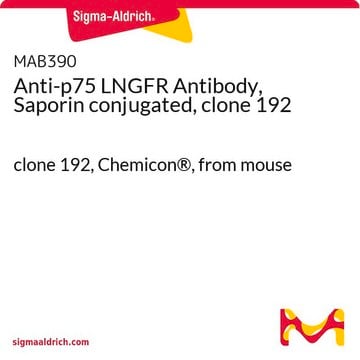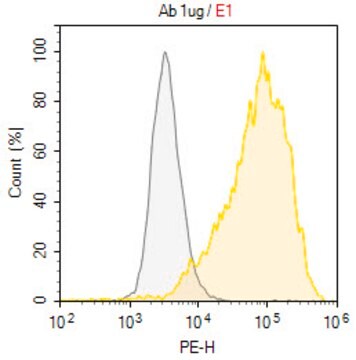MAB365
Anti-Nerve Growth Factor Receptor Antibody, extracellular, clone 192-IgG
clone 192-IgG, Chemicon®, from mouse
Sinonimo/i:
CD271 antigen, Low affinity neurotrophin receptor p75NTR, Low-affinity nerve growth factor receptor, NGF receptor, low affinity nerve growth factor receptor, nerve growth factor receptor, nerve growth factor receptor (TNFR superfamily, member 16), p75 IC
About This Item
Prodotti consigliati
Origine biologica
mouse
Livello qualitativo
Forma dell’anticorpo
purified antibody
Tipo di anticorpo
primary antibodies
Clone
192-IgG, monoclonal
Reattività contro le specie
rat
Produttore/marchio commerciale
Chemicon®
tecniche
immunocytochemistry: suitable
immunohistochemistry: suitable
immunoprecipitation (IP): suitable
western blot: suitable
Isotipo
IgG1
N° accesso NCBI
N° accesso UniProt
Condizioni di spedizione
wet ice
modifica post-traduzionali bersaglio
unmodified
Informazioni sul gene
human ... NGFR(4804)
Descrizione generale
Specificità
Immunogeno
Applicazioni
Neuroscience
Neurochemistry & Neurotrophins
1-5 µg/mL (Non-reducing conditions only) was used on a previous lot.
Inhitibition Assay:
Inhibition on NGF binding {Chandler, 1984}.
Immunoprecipitation:
5 µg/mL, 0.5% triton X-100 buffer; PC12 positive control was used on a previous lot.
Immunohistochemistry:
1-5 µg/mL on rat spinal chord, of a previous lot was used. Other fixatives and methods can also be used.
Qualità
1-5 µg/mL on rat , of a previous lot, (spinal chord, see protocol below); other fixatives and methods can also be used.
Descrizione del bersaglio
Linkage
Stato fisico
Stoccaggio e stabilità
Risultati analitici
Western Blot: NGF-differentiated PC12 cell lysate.
Immunohistochemistry: Rat brain tissue.
Altre note
Note legali
Esclusione di responsabilità
Not finding the right product?
Try our Motore di ricerca dei prodotti.
Codice della classe di stoccaggio
10 - Combustible liquids
Classe di pericolosità dell'acqua (WGK)
WGK 2
Certificati d'analisi (COA)
Cerca il Certificati d'analisi (COA) digitando il numero di lotto/batch corrispondente. I numeri di lotto o di batch sono stampati sull'etichetta dei prodotti dopo la parola ‘Lotto’ o ‘Batch’.
Possiedi già questo prodotto?
I documenti relativi ai prodotti acquistati recentemente sono disponibili nell’Archivio dei documenti.
Il team dei nostri ricercatori vanta grande esperienza in tutte le aree della ricerca quali Life Science, scienza dei materiali, sintesi chimica, cromatografia, discipline analitiche, ecc..
Contatta l'Assistenza Tecnica.








